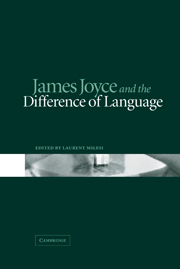Book contents
- Frontmatter
- Contents
- List of contributors
- Acknowledgements
- List of abbreviations
- Chapter 1 Introduction: language(s) with a difference
- Chapter 2 Syntactic glides
- Chapter 3 ‘Cypherjugglers going the highroads’: Joyce and contemporary linguistic theories
- Chapter 4 Madonnas of Modernism
- Chapter 5 Theoretical modelling: Joyce's women on display
- Chapter 6 The lapse and the lap: Joyce with Deleuze
- Chapter 7 ‘sound sense’; or ‘tralala’ / ‘moocow’: Joyce and the anathema of writing
- Chapter 8 Language, sexuality and the remainder in A Portrait of the Artist as a Young Man
- Chapter 9 Border disputes
- Chapter 10 Errors and expectations: the ethics of desire in Finnegans Wake
- Chapter 11 Ex sterco Dantis: Dante's post-Babelian linguistics in the Wake
- Chapter 12 No symbols where none intended: Derrida's war at Finnegans Wake
- Works cited
- Index
Chapter 6 - The lapse and the lap: Joyce with Deleuze
Published online by Cambridge University Press: 22 September 2009
- Frontmatter
- Contents
- List of contributors
- Acknowledgements
- List of abbreviations
- Chapter 1 Introduction: language(s) with a difference
- Chapter 2 Syntactic glides
- Chapter 3 ‘Cypherjugglers going the highroads’: Joyce and contemporary linguistic theories
- Chapter 4 Madonnas of Modernism
- Chapter 5 Theoretical modelling: Joyce's women on display
- Chapter 6 The lapse and the lap: Joyce with Deleuze
- Chapter 7 ‘sound sense’; or ‘tralala’ / ‘moocow’: Joyce and the anathema of writing
- Chapter 8 Language, sexuality and the remainder in A Portrait of the Artist as a Young Man
- Chapter 9 Border disputes
- Chapter 10 Errors and expectations: the ethics of desire in Finnegans Wake
- Chapter 11 Ex sterco Dantis: Dante's post-Babelian linguistics in the Wake
- Chapter 12 No symbols where none intended: Derrida's war at Finnegans Wake
- Works cited
- Index
Summary
There are pass-words beneath order-words. Words that pass, words that are components of passage, whereas order-words mark stoppages or organized, stratified compositions. A single thing or word undoubtedly has this twofold nature: it is necessary to extract the one from the other – to transform the compositions of order into components of passage.
I’ve lapped so long
(FW 625.27)I is a femaline person
(FW 251.31)LAP ONE: DEFINITIONS
There are pass-words beneath order-words, laps beneath lapses, ‘cat-licks’ beneath Catholics – Joy(ce) beneath shame, or James. The free energy of linguistic production can be seen to emerge, with the help of a Deleuzian logic, beneath the pattern of solidified representation. Gilles Deleuze and Félix Guattari's ‘schizoanalytic’ assemblages in A Thousand Plateaus provide novel, erring rather than deferring, inroads into James Joyce's linguistic fissions – nomadic wanderings across the plateaus, whether hills or boglands, of writing and reading. The concept of ‘plateau’, borrowed from Gregory Bateson by Deleuze and Guattari, is defined (though again the word should ideally be submitted to criticism and replacement) as being ‘always in the middle’, and, in connection with the way Bateson originally used it, as ‘a continuous, self-vibrating region of intensities whose development avoids any orientation toward a culmination point or external end’. The explicit philosophy of their book, they claim, resists the ‘order-word’ of a chapter-based structure, to which it prefers a collection of ‘plateaus’:
For example, a book composed of chapters has culmination and termination points. What takes place in a book composed instead of plateaus that communicate with one another across microfissures, as in a brain? We call a ‘plateau’ any multiplicity connected to other multiplicities by superficial underground stems in such a way as to form or extend a rhizome. We are writing this book as a rhizome.
(TP 22)- Type
- Chapter
- Information
- James Joyce and the Difference of Language , pp. 97 - 111Publisher: Cambridge University PressPrint publication year: 2003
- 2
- Cited by



